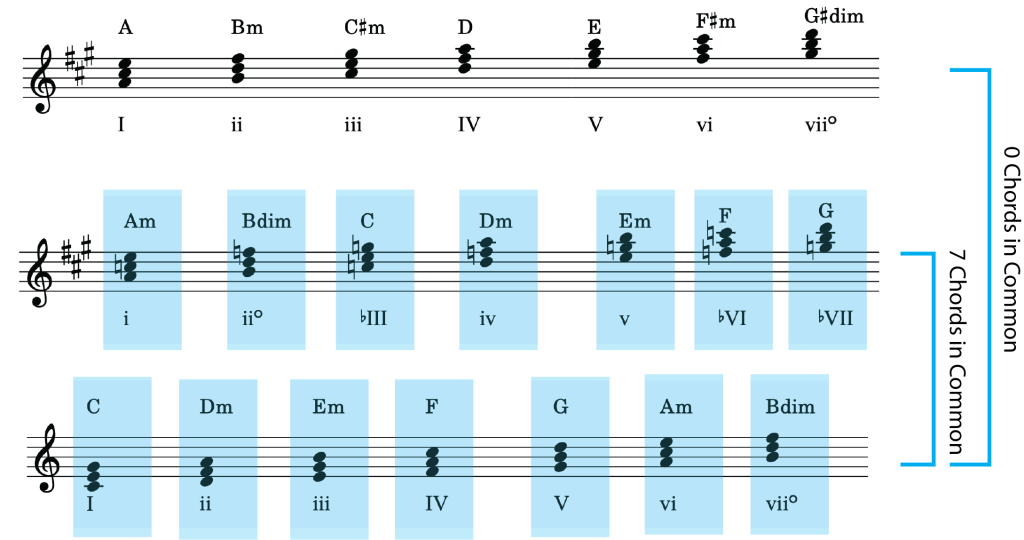V. Chromaticism
Chromatic Modulation
Bryn Hughes
Chromatic Modulation
Modulation to closely-related keys is a relatively easy task; we can find a pivot chord by looking at the group of chords shared between two keys that have nearly-identical key signatures. There are plenty of them. For example:

When two keys are more than one accidental apart on the circle of fifths, however, it becomes more difficult it is to find a pivot chord that will enable a smooth modulation between the two keys.
To modulate to a distantly-related key, that is, a key that is more than one accidental away on the circle of fifths, requires us to use our knowledge of chromatic chords, such as those found through mode mixture. Mode mixture enables us to expand the number of possible pivot chords for modulation. For example, in the key of C major, the chords made possible through mode mixture (i.e. those chords found in C minor, its parallel key), we can now modulate easily to E-flat major (7 shared chords), A-flat major (4 shared chords), B-flat major (3 shared chords), and their relative minor keys, F minor and G minor. Example 2 shows the common chords shared between C major and E-flat major, made possible by using mixture chords in C major.
 Example 2. Shared chords between C major and E-flat major, made possible through mode mixture.
Example 2. Shared chords between C major and E-flat major, made possible through mode mixture.
Example 3 shows a modulation from the key of A major to F major, using iv from A major as a pivot chord. Example 4 shows this technique being used by Verdi in his opera Rigoletto.
Example 3. Modulation from A major to F major using a mixture chord in A major (iv) as a pivot chord.
Example 4. Modulation from D-flat major to F-flat major using a mixture chord in Db major (bVI6) as a pivot chord.
Conversely, we can use diatonic chords in the old key as mixture chords in the new key to modulate to distant keys in the “sharpwise” direction on the circle of fifth. Example 5 shows the potential pivot chords when modulating from C major to A major by way of the diatonic chords in C major as mixture chords in the new key of A major.
Example 5. Potential pivot chords when modulating from C major to A major.
A modulation using this technique in a chorale setting is shown in Example 6.
Example 6. Modulation from A-flat major to C major using a diatonic chord in A-flat major (vi) as a pivot chord that is interpreted as a mixture chord (iv) in C major.
Example 7 shows an interesting chromatic modulation from Brahms’s Waltz, op. 39, no. 14. Here, Brahms uses a diatonic viio6 chord in the local key of G major to pivot to E major, reinterpreting the chord as iio6, a mixture chord in the new key of E major.
Example 7. Modulation from G major to E major using a diatonic chord in G major (viio6) as a pivot chord that is interpreted as a mixture chord (iio6) in E major.
Common-Tone Modulation
Sometimes we can use a common-tone, rather than a pivot chord, to modulate to distantly related keys. In particular, the key areas that are a third away from the home key are easily modulated to using this technique.These keys, chromatically altered tonics that are a third away from the home key, are called “chromatic third” or “chromatic mediant” relations. For example:C and Ab major (share the common tone C), C and Eb major (share the common tone G), C and A major (share the common tone E), C and E major (share the common tone E).
Example 8. Common tones shared between chromatic mediants.
We can modulate to distant keys in several ways. Chromatic modulation refers to a modulation to a distant key by way of a chromatic chord. Enharmonic reinterpretation involves respelling and resolving a chromatic chord (usually a German augmented sixth or diminished seventh chord).
The German augmented-sixth chord may be respelled to resemble a dominant seventh chord. If you use the German augmented-sixth from the home key, the resulting modulation will be up a half step. Likewise, you can re- spell a dominant seventh chord to resemble a German augmented-sixth chord. If you use the dominant seventh chord in the home key, the resulting modulation will be down a half step. You can, of course, use this trick with any dominant-seventh chord (say, a secondary dominant), opening up numerous possibilities for modulation.
- Coming soon!
Media Attributions
- chromatic modulation – closely related keys
- distantly related keys – mixture to diatonic
- distantly related keys – diatonic to mixture

